
Early Small Crown Submariners were designed to be fitted with "Swiss Rivet" bracelets manufactured for Rolex by the world renowned maker Gay Frères, a company that was acquired by Rolex in 2001. The same bracelets were also used for other Rolex Sport watches such as the GMT Master, Explorer, and Turn-o-graph models. Bracelets made for sport watches at that time were only recently introduced to the market and were very much a work-in-process. Their early elegant designs were much lighter than the heavy-duty bands produced in subsequent decades. Due to the lighter gauge metal, the bracelets tended to stretch over shorer periods of time and clasps would break more easily. Despite these short-comings, Swiss Rivet bracelets were the best quality available for watches from that time period and relatively expensive as well.
Rolex also commissioned somewhat lesser quality bracelets from manufacturers that were based outside Switzerland to help reduce the duties on watches imported for sale in the United States, the United Kingdom and Mexico. The most notable manufacturer, C&I was based in the United States and manufactured meaningful quantities for about two decades starting in 1959. These bands had thinner hollow rivets and a lighter gauge steel than its Swiss-made counterpart. Another short-coming on the U.S. made bracelets were the end pieces which are unmarked and have a tendency have a very loose fit.
The later bracelets described in this section were intentionally designed to work not only with their contemporary watches but also as replacements that would retrofit seamlessly with earlier models. Some would also argue that the later-period Folded and Solid Link bracelets are sturdier and more comfortable than earlier Rivet Links as well. However, many purist collectors of Vintage Rolex watches have a passion for matching their fine and rare timepieces with period correct bracelets.
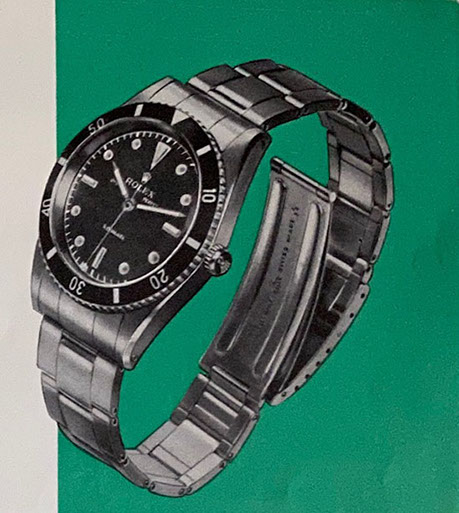
Swiss Rivet Bracelet Made by Gay Frères as illustrated in this Rolex brochure for the Submariner Ref. 6204 from 1950s
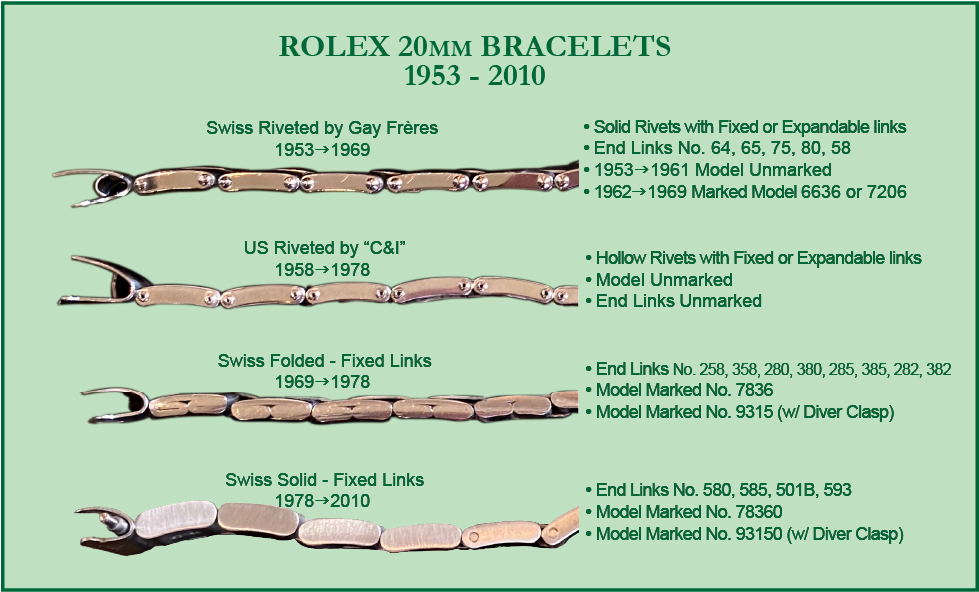
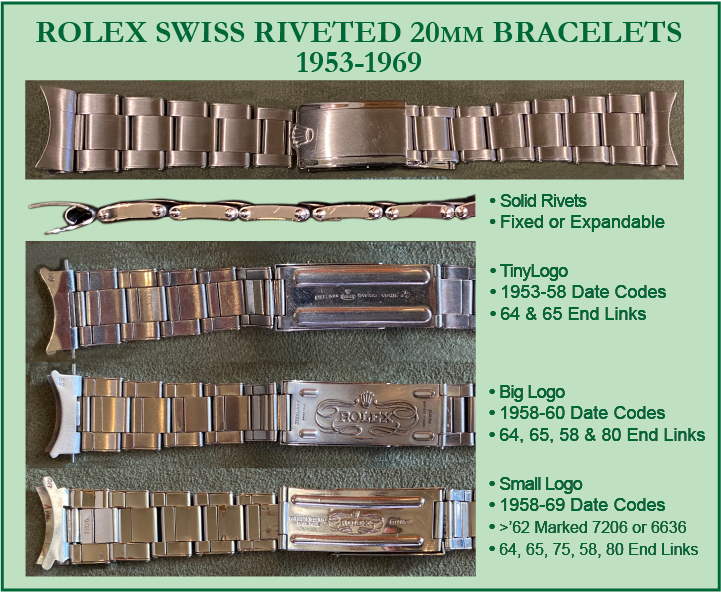
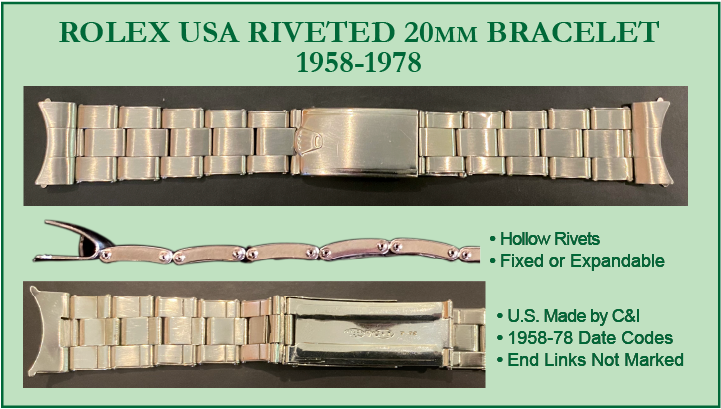

Spring-loaded Expandable Links were made in the 1950s and 1960s by Swiss bracelet maker Gay Frères and in the U.S.A. by C&I for use on Rolex Sport Models like the Submariner, GMT Master and Explorer.
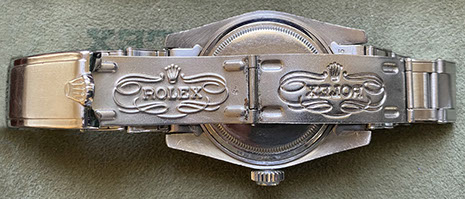
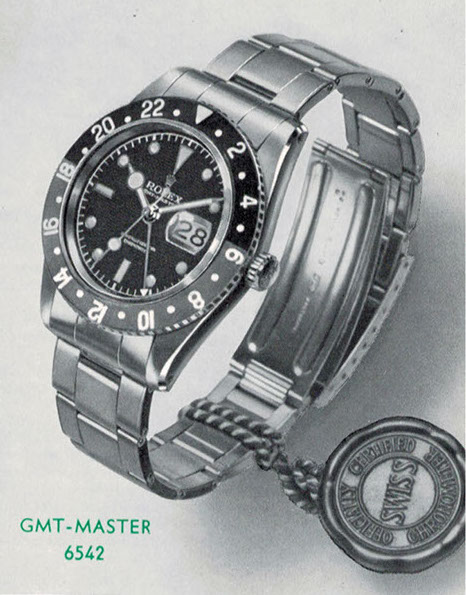


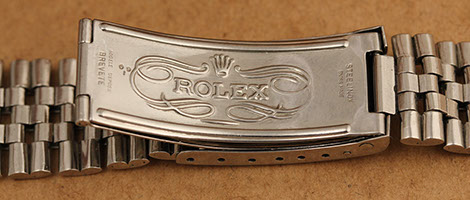
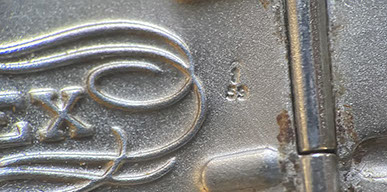
Some of the early rivet-style bracelets, both U.S. and Swiss-made, had spring loaded expandable links. This well intentioned feature was not widely used because it was unreliable and usually the first component to fail. Rolex abandoned the design altogether in the next generation of their folded link bracelets around 1978. It is not surprising that few expandable bracelets survive in good condition.
Almost every Swiss and U.S. made bracelet clasp has a batch number and year stamped on one of its' leaves. These markings were intended for quality control purposes, similarly to the case back date codes.
The Swiss Rivet "Big Logo" bracelet is named after the large and intricate flourish designs on the clasp. They were produced for Swiss Rivet and Jubilee bracelets for a few short years from 1958-60, the beautiful markings on the clasp and its rarity make it one of the most sought after Rolex bracelet variants. Well preserved examples are delightful to behold and still suited for daily wear.
Big Logo clasps were also fitted on "Jubilee" style bracelets and used for other Rolex Models, including the GMT Master. There were also Big Logo clasps made to fit 18K Swiss Rivet bracelets.
In 1961, the Swiss Rivet bracelets started to bear reference number stamps on the largest link at 12:00. Most of the bracelets have the "7206" stamped indicating fixed links and a few are found to have "6636," for those with expandable links. The U.S. made rivet bracelets did not have a reference number stamped.
The end links on Swiss Rivet bracelets were always stamped with a two digit code while U.S. rivet bracelets had no markings on the end links. Folded link bracelets and solid link bracelets had three digit codes. All 20mm end links will work on Rolex Sport models, while some links are better suited for thicker cases. The following is a partial bu pertinent list of common end links and their uses:
- #64 Fixed - Swiss Rivet ~1953-1958
Submariner, GMT Master, Explorer - #65 Fixed - Swiss Rivet ~1953-1958
Submariner, GMT Master, Explorer - #80 Fixed - Swiss Rivet 7206/6636 ~1958-1969
Submariner, GMT Master, Explorer - #58 Fixed - Swiss Rivet 7206/6636 ~1958-1969
GMT Master, Explorer - #258 Fixed - Folded Link 7836/9315
#358 Removable - Folded Link 7836/9315
GMT Master, Explorer - #280 Fixed - Swiss Folded Link 7836/9315
#380 Removable - Swiss Folded Link 7836/9315
Submariner, GMT Master, Explorer - #282 Fixed - Swiss Folded Link 7836/9315
#382 Removable - Swiss Folded Link 7836/9315
Tudor Chronograph - #285 Fixed - Swiss Folded Link 9315
#385 Removable - Swiss Folded Link 9315
Sea-Dweller - #580 Removable - Swiss Solid Link 78360/93150
Submariner, GMT Master, Explorer - #585 Removable - Swiss Solid Link 78360/93150
Sea-Dweller
Fixed end links require a jeweler or bracelet specialist for installation or removal. Adjustments to fit a particular watch is also recommended for the best fit. Removable end links can be changed easily by taking out the spring bar with a simple tool and can be done by most laymen.
Adding or removing links to change the bracelet size on all rivet or folded link bands should only be carried out by a jeweler or bracelet specialist. However, Rolex Solid links can be added or removed with the proper size screw driver and do not require a specialist.
RolexHaven.com is intended for informational purposes only and is in no way sponsored, endorsed,
or affiliated with Rolex U.S.A., Rolex S.A. or any other Rolex worldwide subsidiary. © All Rights Reserved 2020